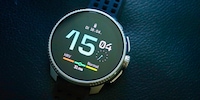

ScanWatch by Withings: the (almost) perfect hybrid smartwatch
ScanWatch is Withings' newest wearable. The hybrid smartwatch claims to deliver a month of battery life and check a range of vital functions. I put it to the test.
Pedometers are out, smartwatches are in. These wearable gadgets show far more than just your step count or the time. Heart rate monitoring and GPS tracking are also fast becoming standard. According to the manufacturer, the ScanWatch enhances basic data with «a medical-grade ECG an oximeter for SpO2 measures and an exceptional battery life of up to 30 days». So, Withings doesn't just want the hybrid smartwatch to go a month without needing charging, but also to be a doctor on your wrist. As I fastened the watch for a two-week test, I wondered whether so many features would come at the expense of the essentials.

Unboxing: a fabric case that's a little different
The packaging is a handy size. Anything else would have surprised me about a hybrid smartwatch in such a slim format. It's a hybrid because the watch combines the analogue design of a conventional wristwatch with the features of a smartwatch. The front of the box shows a front view of the watch, its name and «clinically validated» on a green background. According to the manufacturer, the ScanWatch was developed with experts from the UCSF Hypoxia Research Laboratory, the Hôpital Georges Pompidou, the Centre Cardiologique du Nord and the Ludwig Maximilien University of Munich. On the back, I read how the latest Withings gadget is set to impress. The box contains a quick guide and a stylish dark grey fabric case. That's it.
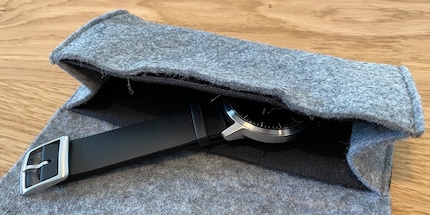
I assumed that I'd find the watch and some accessories in the grey pouch. The extraordinary watch case has three inner pockets. The middle compartment contains the watch and I found a USB cable with a wireless charger in the top pocket. The bottom section is empty. I could put the manual in there, for example, to keep everything for the ScanWatch in one place.
I got the feeling that the packaging had a strong environmental focus. The start guide and the case both look like they could be recyclable. Watches usually come in a hard case box with a small cushion and a lot of fuss. Withings has taken a more sustainable route here, which I like.
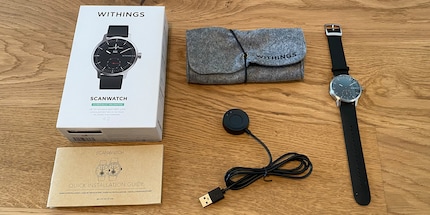
Installation: incredibly easy and super quick
There's not a lot in the quick guide. Just that I should download the Health Mate app and then follow the rest of the instructions there. The app is available for both iOS and Android. First up, it wanted me to log in with my Withings account or create one. Then it asked me which product I wanted to install. I found the ScanWatch under «fitness watches». I clicked on «Install» to set up «the world's most advanced health wearable» according to Withings. I had to press down the crown for two seconds, then the ScanWatch switched itself on. The app and the mini display on the watch confirmed that they had found each other. With a six-digit code, I made them inseparable. Lastly, I entered my measurements so that the ScanWatch knew how to classify my sporting performance.
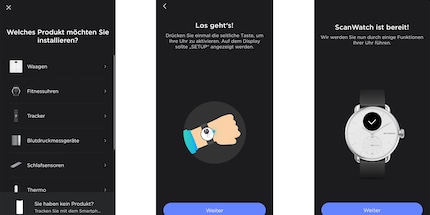
This was followed by a detailed introduction to all of the different functions. I found out that I could flick through the menus by turning the crown. Pressing the crown confirms the selection. This transmits the command digitally. Next, the ScanWatch explained what an ECG is and asked whether I wanted one. So I selected «ECG» in the menu, laid my left arm – which was wearing the watch – on the table and placed my right index and middle finger on the watch face. There's another sensor there, whose data the ScanWatch needs to create an ECG.
I do the same when I want to know my oxygen saturation level or run a Respiratory Scan. Last but not least, the watch checks for atrial fibrillation. All of my results were in the green range, so I didn't have anything to worry about to start with.
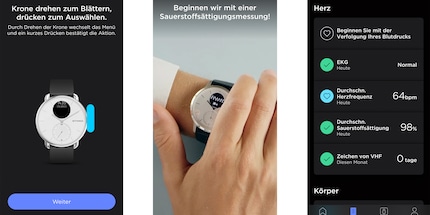
Functions: a doctor's surgery and gym always on hand
The Withings ScanWatch is water-resistant up to 50 m or 5 ATM, made with sapphire glass and fluoroelastomer. The manufacturer has also revamped the display compared to its existing product portfolio. The 13 mm-diameter PMOLED screen is new with more than 9,000 pixels and 260 nits. I was struck by the brightness at first glance: even though the display is really small in comparison to the 42 mm watch, I can read all of the information perfectly. After intensive showering, washing up and hand washing, I can confirm that the watch is water-resistant.
If I wanted, I could display and look through incoming calls, texts, WhatsApp messages, Instagram comments or Facebook likes. I could bring up other notifications like appointments or my daily statistics like step count, calories, distance covered, floors climbed and heart rate by turning the crown and via the screen.
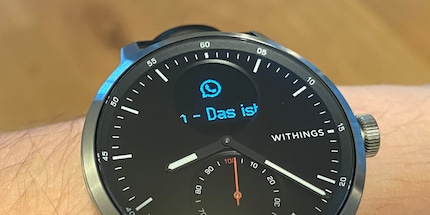
Thanks to the introduction, I know how all of the ScanWatch health tests work. The watch told me what they're good for and what they prevent in detail. For example, it measured my heart rate continuously to warn me about an irregular heartbeat. It measured my resting heart rate too. The EGC, which I brought up on the watch display in 30 seconds, can be displayed in more detail in the app and used for diagnostic purposes. I did multiple ECGs in different situations and at different times and always got the same results. The measurements seemed to be right.
Thanks to the additional sensor on the bottom, the ScanWatch can also measure my oxygen saturation level. The phone uses red and infrared LEDs and light-sensitive photodiodes to record the oxygen saturation level of blood in the veins that run under where I'm wearing the watch. The sensors work with the reflection and absorption principles of light waves. After 30 seconds, I received my blood oxygen content. My model had a little more difficulty when it came to these measurements. Sometimes I got inaccurate results or none at all. At least the watch noticed inaccurate data itself and issued an appropriate message. I had to keep my arm really still. As soon as I didn't lay the fingers on my other hand perfectly on the watch face, the ScanWatch had problems.
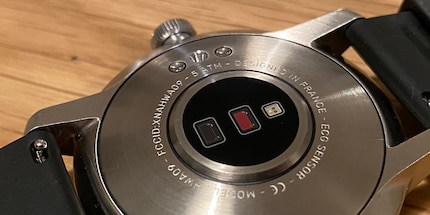
The intelligent watch also claims to identify breathing irregularities during sleep. If I activate the Respiratory Scan feature, the watch measures movements, oxygen saturation levels and breathing rate via my heart rate. This is how it recognises whether and when I breathe irregularly in my sleep. The Withings wearable also displays my sleep phases, duration and sleep disturbances. The watch uses this data to create a smart alarm clock, which wakes me with vibrations as soon as the ScanWatch notices that I'm in the waking phase.
The ScanWatch is also a sports watch. The hybrid smartwatch has more than 30 predefined sports. From football to running to swimming, it's all there. In the corresponding training mode, it shows me how long I train for, measures my heart rate and displays my movements. With activated Connected GPS, I can also see details like distance covered, elevation gain and speed after a session. By the way, Connected GPS means that the watch can't track my route. It has to be connected to a device that offers this feature, such as my iPhone. I have to take it with me when I go jogging to track my route.
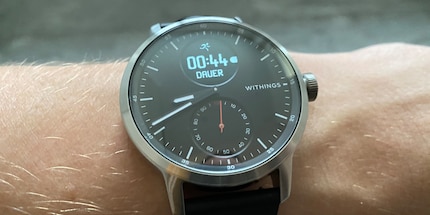
Pros: battery life, design and sports functions
I experienced the long battery life myself. I haven't had to charge the ScanWatch once since I got it out of its packaging and activated it. At that point, the display told me that the battery was 48% charged. Two weeks later, it was still at 11%. If I were to put the watch in energy-saving mode, Withings promises a further 20 days of battery life. In this mode, however, I can only read the time and log my activities.
A feature that I personally find important is Quicklook. If I activate this feature, the watch display is constantly turned off. As soon as I move my wrist to look at the ScanWatch, the screen lights up for five seconds. So I don't have to press the crown first to bring light into the dark.
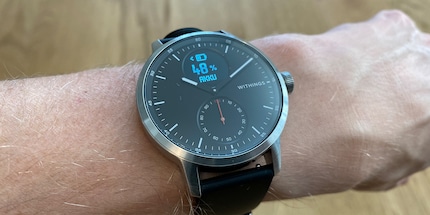
I also like the Do Not Disturb feature. During a meeting, for example, I can tell my watch to keep quiet and hold off on notifications, vibrations and sounds. The ScanWatch not only shows me the time; it also measures it. The watch has an alarm, a stopwatch and a timer. Practical when I don't have my phone to hand. The mini dial under the display – that I thought was the second hand or stopwatch – is in fact a percentage-based progress indicator of my daily goal.
A watch that counts my steps isn't a must-have for me. But because the ScanWatch does it anyway, I just use the feature for fun. The world isn't going to end if I don't achieve my low goal of 7,000 steps per day. However, this failure wouldn’t let me go and I took myself off for a walk the next day. The fact that the Health Mate app provides further details also speaks to me as a statistics freak.
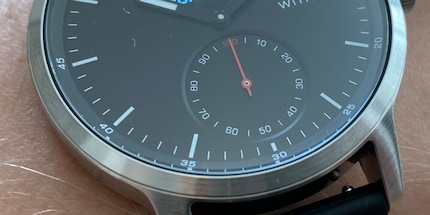
Cons: medical features and menu navigation
It warns me about atrial fibrillation, can create an ECG at any time and measures the oxygen saturation level in my blood. Despite this, I would go to my doctor for these tests if I had any serious concerns. The watch may actually identify indications of health problems which would prompt me to go to the doctor. But the medical features can also lull me into a false sense of security. If the ScanWatch isn't giving me any warnings, am I automatically healthy? Whether clinically proven or not, I think it's risky to rely on a wearable for your wellbeing – despite what it says in the manual.
Even though the display is razor sharp, I found the menu navigation on the ScanWatch to be less than optimal. It's great that I can do everything by simply turning and pressing the crown. But I'd like a better distribution of functions, via structured submenus for example. It takes a while to go through all of the modes and features just by turning the crown. Especially when I accidentally slip and have to start from the beginning. The Fossil Collider Hybrid HR's solution is clearer with more logical organisation. Its screen isn't razor sharp or high-resolution, but it's a bit bigger and clearer.
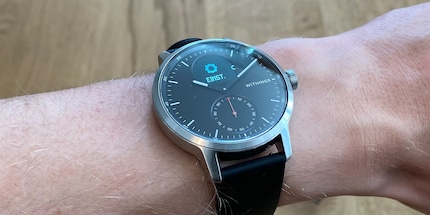
Verdict: an asset to my wrist
The ScanWatch feels well made. The rubber strap, however, looks cheap at first glance. Once I started touching and wearing it, I slowly got to like it. If I hadn't, though, I could have bought a fancier one from the Withings shop. The strap sits well and a loop keeps the part that sticks out over the clasp in place. With a black dial in a 42 mm stainless steel case, the hybrid smartwatch looks elegant yet discrete. Exactly what I like in a watch. The ScanWatch is also available with a white dial and a 38 mm case. As I prefer to wear chunkier watches, I found that even the bigger version could be a little wider. At 83 grams, the ScanWatch weighs more than other models. I like this too, because I prefer to feel my watch when I wear it.
For me, the extra medical functions are «nice to have», but nothing more. Yes, it's exciting to see what my ECG says and how the oxygen saturation level in my blood is looking. And, no, it's not necessary to know all of this. If I'm not feeling good, I go to my doctor – whatever my watch says. However, even if it's not useful, it's not harmful either. Who knows whether the ScanWatch will actually save someone's life in the future with an atrial fibrillation warning. Either way, I love Withings' smartwatch. The essentials and the fun stuff are equally impressive. It's easy to change between menus, the data is reliable and the battery virtually never wanes.
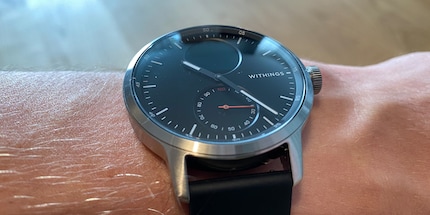
I recommend the hybrid smartwatch to anyone who likes elegant watches with the added extra of features and technological advances. But because the Fossil Collider Hybrid HR is only two thirds of the price of the ScanWatch, I would personally go for the former. The Fossil doesn't offer ECG, SpO2 or sleep apnoea measurements, but it does have an equally long-lasting battery, organised menu navigation and a bigger display.
When I'm not stuffing my face with sweets, you'll catch me running around in the gym hall. I’m a passionate floorball player and coach. On rainy days, I tinker with my homebuilt PCs, robots or other gadgets. Music is always my trusted companion. I also enjoy tackling hilly terrain on my road bike and criss-crossing the country on my cross-country skis.

